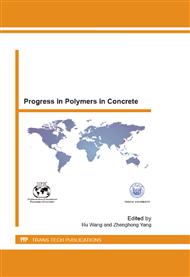p.3
p.12
p.21
p.26
p.35
p.45
p.57
p.68
p.77
Remodeling of Deteriorated Irrigation Aqueducts Using Precast Polymer Concrete Flume
Abstract:
This study is designed to review the causes and modes of deterioration in irrigation aqueducts constructed with reinforced concrete, and introduce existing rehabilitation and new remodeling methods. As a result, because of the typical nature of irrigation aqueducts that are exposed to severe natural environment, the causes and modes of deterioration were more complex and diverse than other concrete structures. Also, due to the thinner cross sectional thickness of the structure, conducting a rehabilitation work was turned out to be difficult. As an active method for settling this problem, this study developed a method to remove the entire flume, upper structure of aqueduct, and replace with a precast flume constructed with polymer concrete. A loading test was performed using full-scale specimens, and then the suggested remodeling method was implemented in the actual field structures. The investigation showed that the suggested remodeling method was appropriate to secure the sustainability.
Info:
Periodical:
Pages:
35-44
Citation:
Online since:
April 2013
Price:
Сopyright:
© 2013 Trans Tech Publications Ltd. All Rights Reserved
Share:
Citation:


